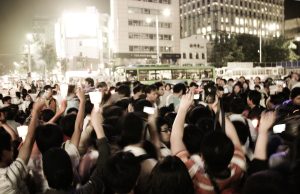As COVID-19 restrictions ease all over the world, events that were long postponed due to the pandemic are amassing unwieldy crowds of people desperate to gather and celebrate after years of isolation. In November 2021, artist Travis Scott hosted his disastrous Astroworld concert in Houston, where a crowd surge in the packed venue left 10 concertgoers dead. In early October 2022, over 120 football fans fell victim to a fatal stadium crush in Java, Indonesia. Just weeks later, over Halloween weekend, thousands of young adults and teenagers gathered together in the narrow alleyways of Itaewon, a popular nightlife district in Seoul, South Korea, known for its large foreigner population. What started as a time for celebration ended in fatal disaster, with over 150 partygoers falling victim to a crowd crush.
Following the horrific tragedy in Itaewon, enraged citizens are demanding answers. Unlike the incidents in Houston and Java, where the immediate responses were increased scrutiny of concert venues and sports stadiums, followed by criticism of organizations and security responsible for coordinating and executing these large events, the Halloween event in Itaewon had no official sponsors or organizers to pin the blame on. Instead, the events leading up to the deadly festivities all point to extremely careless government oversight, with mounting pressure from angry citizens for the government to be held accountable for its incompetence. Investigations of police officers and public officials are revealing lapses in judgment and action from the police department, and citizens are calling for President Yoon Suk-yeol to take responsibility for the disaster.
While the Halloween festivities in Itaewon revealed lapses of judgment and foresight made by South Korean authorities, the tragedy also played a unique role in bringing to light other pervasive public safety and urban planning issues that have plagued Seoul for years. Not only has there been further investigation into the size of the alleyway in Itaewon that created the deadly bottleneck, but to many South Koreans, seeing the tightly-packed bodies stuffed in this narrow alley was horrifyingly reminiscent of the congestion citizens living in Seoul experience almost daily on their work commutes.
With an area of about 39,000 square miles, South Korea is not a big country. However, it is home to a population of over 50 million people, 9.6 million of which live in Seoul as of 2022. Overcrowding is unavoidable in such a densely populated city. Nowhere is this density more acutely felt than in the city’s public transportation system, which as of 2019 was utilized by 7 million people daily.
Following the events in Itaewon, anxiety surrounding the commonplace overcrowding on public transportation has increased; something as mundane as a morning commute could have deadly consequences.
Heightened awareness of the public safety dangers posed by overcrowding and demands for efforts to address this issue have prompted swift responses from transportation authorities to address one train line in particular. The “hell train,” or Line 9 on the Seoul metro, runs through commercial business districts like Gangnam and Yeoiudo. Line 9 earned its nickname of “hell train” because it is home to some of the most severe overcrowding in the city during rush hour. At its worst, in cars meant to accommodate only 160 passengers at a time, over 400 people are crammed together, unable to move or exit the train at their intended stop. Since the Itaewon tragedy, the city has announced plans to add more cars to the hell train and increase the number of trains in operation in the next year or so.
Other crowd control tactics that transportation authorities are scrambling to implement in the wake of the Itaewon tragedy include temporarily stationing officials in the subway stations who prevent people from boarding the trains if they are too crowded, putting up posters that list the busiest train times for the awareness of commuters, and stickers on train platforms that urge passengers to stand in lines to prevent congestion.
These efforts to reduce overcrowding have not been limited to public transportation in Seoul, but have spilled over to other parts of the country. In the wake of the Itaewon incident, the Gyeonggi provincial government announced and confirmed in early November 2022 a no-standing policy on buses traveling from the cities in Gyeonggi province to Seoul. This means that these buses will no longer accept passengers if there are no vacant seats remaining in the vehicle.
After years of complacency and insufficient solutions, the aftermath of the Itaewon tragedy has had the effect of jumpstarting action to improve Seoul’s public transportation system as overcrowding has been elevated to an important public safety issue.

































